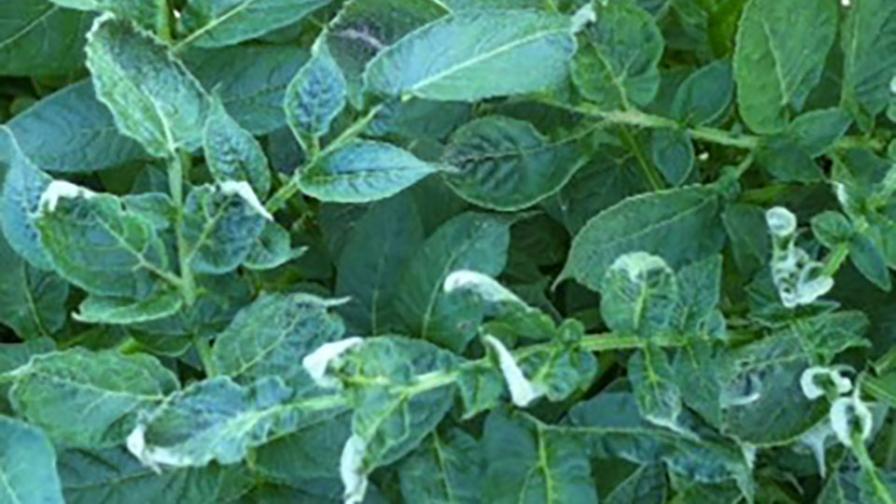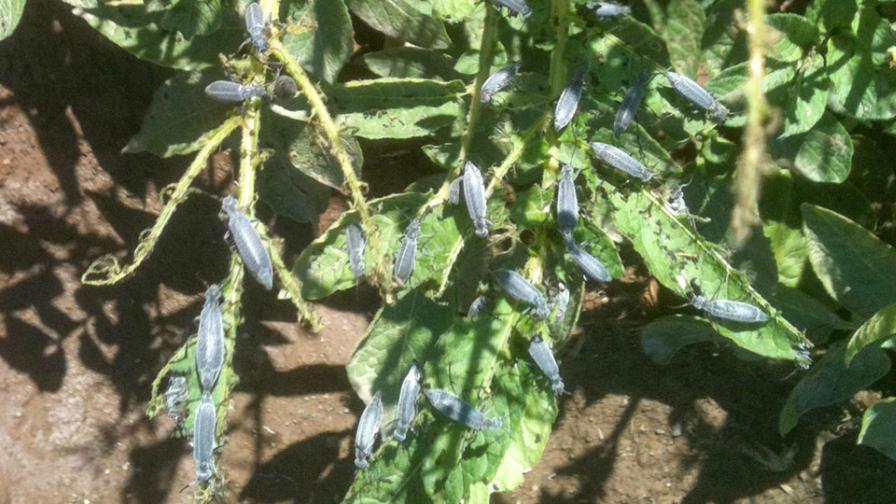5 Steps To Distinguish Abiotic vs. Biotic Problems in Potatoes
Many things can go wrong when growing a potato crop. Some problems are caused by biotic factors — living organisms like pathogens, weeds, insects, and nematodes. Other problems are abiotic — resulting from things like mechanical damage, soil compaction, weather extremes, nutrient deficiency or toxicity, and misuse of chemicals.
Here are some general guidelines for distinguishing abiotic and biotic problems.
1. What Plants Are Affected?
Abiotic causes of potato problems may also affect nearby plants. For example, 2,4-D herbicide drift that results in injury to potatoes may also affect broadleaf weeds in the area and other sensitive crops like beans or peas. This is not typical of fungal pathogens and many other biotic causes of plant problems that tend to be specific to their host, or may even be specific to cultivars (e.g., disease-susceptible vs. resistant cultivars).

When investigating potato problems in fields, I often look at nearby weeds and crops to see if similar symptoms are showing up on unrelated plant species — this usually indicates an abiotic problem. In this case, potatoes were injured by 2,4-D herbicide that drifted from an application that was only intended to control Russian thistle nearby on the roadside.
Photo by Carrie H. Wohleb
2. Uniform or Irregular Pattern of Symptoms?
Symptoms that result from abiotic problems tend to appear in regular, linear, or uniform patterns in a field. Chemical-related injury that results from mistakes with ground rig applications usually shows up in swaths that match the width of the sprayer. Hail usually causes uniform damage across entire fields. By contrast, biotic agents almost always cause symptoms in random or irregular patterns. Seed-borne bacterial blackleg (caused by Pectobacterium spp. or Dickeya spp.) appears wherever an infected seed potato is planted and results in a random pattern of individual diseased plants throughout the field.
Late blight (caused by Phytophthora infestans) can also be seed-borne, but it tends to spread very quickly. By the time you observe symptoms, they appear in random “hot spots” or zones where the problem started and has subsequently spread. Another pattern that is particularly common for insect-related problems is an edge pattern. Insect pests (like Colorado potato beetles, aphids, leafhoppers, and potato psyllids) tend to infest fields from the edge and then move inward.
3. Are Symptoms Uniform or Varied?
Symptoms from abiotic causes are often linked to an incident and can appear suddenly. Symptom expression is usually uniform among affected plants. Herbicide drift injury, like insect damage, often occurs at the edge of a field. Symptoms appear shortly after an herbicide application is made, and the affected plants usually show the same set of symptoms. Linking problems to an incident can be easy if you are aware that it happened (e.g., weather-related events like storms, field operations you control, or irrigation system breakdowns) and difficult if you did not observe them (e.g., applications made by others that result in herbicide drift and carryover, or spray tank contamination). Symptoms of biotic problems are often uneven, and time of appearance and severity varies among plants as the problem spreads. This can be obvious as you walk through the field and observe symptoms that vary in severity or degree of plant damage, depending on how close the affected plants are to the original source of the problem.
4. Is the Problem Spreading to More Plants?
Most biotic problems can spread or increase if environ-mental conditions are suitable. The outcomes are not always serious, because many pests and diseases can be controlled during the season by modifying management practices or applying pesticides. If biotic problems are diagnosed early, it may be possible to limit spread and avoid significant economic losses. By the time you notice abiotic problems, it is often too late to take corrective action. You can’t un-bruise a potato. Some abiotic problems can be dealt with in the off-season, like tillage to reduce soil compaction or liming to correct a soil acidity problem.
5. Signs?
Signs are the physical evidence of a pest or pathogen — like insect larvae, fungal mycelium and spores, bacterial ooze, webs, and excrements from pests like cast skins, frass, or slime. Some signs are microscopic, like nematodes, and may only be found by submitting samples to diagnostic labs. There should be no evidence of a pest or pathogen when problems are caused by abiotic factors except when pests and pathogens are attracted to stressed plants, which complicates matters by sometimes resulting in secondary issues.
Applying the Five Steps in the Real World
We used these five steps to diagnose air pollution injury on potato and bean crops in the Columbia Basin in Washington.
We received several calls from growers who reported unusual stippling (small, brown-black spots) on the surface of leaves in the summer of 2014.
These symptoms were found on both potato and bean crops at roughly the same time (Step 1) and were uniformly distributed across the fields (Step 2).
They appeared suddenly (Step 3) and not long after several areas in the region had been blanketed in smoke from the Carlton Complex fire. Air pollution sensors nearby also reported elevated levels of pollutants, like ozone, that are associated with wildfire smoke and are known to cause injury to plants.
The symptoms did not spread or progress (Step 4) — in fact, new potato growth was normal — and we did not recover any signs of a pest or pathogen on leaf samples observed under magnification (Step 5).
We also consulted vegetable specialists from other areas to verify that the symptoms we observed were characteristic of air pollution problems seen in other regions.
Exceptions Do Exist
There are exceptions to these rules. Blister beetles are swarming pests that occasionally encounter and feed on potatoes. They can completely defoliate potatoes as they migrate through the area. Once they are gone, there are no signs that indicate they were there, and no spread of symptoms.

Blister beetles can defoliate potatoes and move on, mystifying growers about what happened to their crops. The only indication may be the chewed leaves and edge pattern.
Photo by Carrie H. Wohleb
This pest will also feed on other broadleaf plants like alfalfa and clover (when not feeding on grasshopper eggs). In this case, the edge pattern (and the chewed-up leaves) may be the only observation that suggest a biotic cause.










